NUNAVUT


ORIGIN OF NAME: Inuktitut for "our land."
CAPITAL: Iqaluit.
ENTERED CONFEDERATION: Organized 1 April 1999.
COAT OF ARMS: The shield is flanked on the left by a caribou and on the right by a narwhal, symbolizing the land and sea animals that provide sustenance for the people. The five circles refer to the life-giving properties of the sun. Above the circles is the North Star. A qulliq, or Inuit stone lamp, appears to the left of the inuksuk, to represent light and the warmth of the family and the community. An iglu sits above the shield to represent the traditional life of the people. The Royal Crown above the iglu symbolizes public government.
FLAG: In the center is a red inuksuk, which symbolizes the stone monuments used throughout Nunavut as landmarks. In the upper right is a blue star on a white field representing the North Star, the traditional guide for navigation. The left side of the inuksuk is gold.
TIME: 8 AM AST = noon GMT; 7 AM EST = noon GMT; 6 AM CST = noon GMT; 5 AM MST = noon GMT.
1 LOCATION AND SIZE
Nunavut was formerly a part of the Northwest Territories until 1999, when it became a separate territory. Nunavut is the largest political subdivision in Canada, with 18 percent of the total area of the country. Nunavut has a total area of 708,434 square miles (1.83 million square kilometers), about eight times the size of the United Kingdom.
Nunavut includes most of Canada north of the 60th parallel, except the Yukon, the Northwest Territories, and portions of Québec and Newfoundland. Nunavut is bordered on the north by the Arctic Ocean and polar ice; on the northeast and east by Baffin Bay and Davis Strait; on the southeast by Hudson Strait and Hudson Bay; on the south by Manitoba; and on the west by the Northwest Territories. From the 60th parallel, Nunavut stretches 2,212 miles (3,560 kilometers) to the North Pole. Nunavut covers 870,424 square miles (2,254,402 square kilometers) and includes the islands in Hudson, James, and Ungava Bays. Across the Kennedy Channel in the far northeast, Greenland lies less than 25 miles (40 kilometers) from Nunavut's Ellesmere Island. Canada's geographic center is in Nunavut, about 19 miles northeast of Baker Lake. The North Magnetic Pole (the place on Earth at which a compass needle actually points) is located off the coast of Bathurst Island.
2 TOPOGRAPHY
The landscape of Nunavut has been shaped by ice sheets and glaciers, which carved out deep valleys and fjords. Upon melting, ancient ice sheets deposited an assortment of clay, stones, boulders, and ridges of sand and gravel. Today, glaciers and ice caps cover about 57,900 square miles (150,000 square kilometers) of Nunavut. However, in the 21st century, rising temperatures, retreating sea ice, and thawing permafrost are altering the landscape of Nunavut.
Major mainland rivers include the Back and Coppermine, which flow north to the Arctic coast. The Thelon, Kazan, and Dubawnt rivers flow into Hudson Bay. Permafrost prevents runoff from soaking into the ground, causing rivers and streams to flow rapidly after the spring thaw.
Nunavut's highest ground is found on Baffin Island and Ellesmere Island, where many peaks rise 4,900 feet (1,500 meters) to 6,500 feet (2,000 meters) above sea level. The highest mountain is Mount Barbeau, at 8,583 feet (2,616 meters) on northern Ellesmere Island.
Nunavut Population Profile
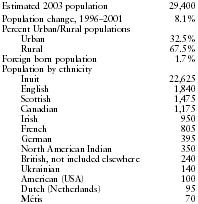
| Estimated 2003 population | 29,400 |
| Population change, 1996–2001 | 8.1% |
| Percent Urban/Rural populations | |
| Urban | 32.5% |
| Rural | 67.5% |
| Foreign born population | 1.7% |
| Population by ethnicity | |
| Inuit | 22,625 |
| English | 1,840 |
| Scottish | 1,475 |
| Canadian | 1,175 |
| Irish | 950 |
| French | 805 |
| German | 395 |
| North American Indian | 350 |
| British, not included elsewhere | 240 |
| Ukrainian | 140 |
| American (USA) | 100 |
| Dutch (Netherlands) | 95 |
| Métis | 70 |
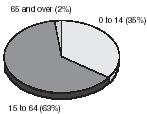
| City | Population, 2001 |
| Iqaluit | 5,236 |
| Rankin Inlet | 2,177 |
| Pangnirtung | 1,276 |
3 CLIMATE
Average January temperatures range from -4° F (-20° C ) along southern Baffin Island to -35° F (-37° C ) along northern Ellesmere Island. Average July temperatures range from 50° F (10° C ) along the southern mainland to 36° F (2° C ) in the north; inland temperatures are warmer. The average temperatures in Iqaluit are -22° F (–30° C ) in January and 41° F (5° C ) in July. Grise Fiord, the northernmost community in Nunavut, has an average temperature in January of -31° F (–35° C ) in January and 50° F (10° C ) in July. As in the Yukon, the varying amounts of daylight over the year are an important influence on the climate: between 20 and 24 hours of daylight in June and up to 24 hours of darkness in December. In January, Iqaluit has only about 4.5 hours of daylight, but 20 hours
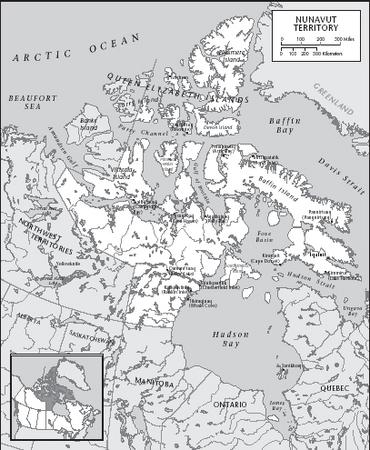
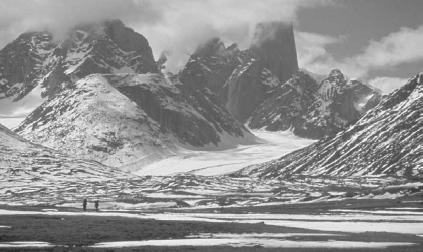
Annual precipitation ranges from less than 3.9 inches (100 millimeters) around Ellesmere Island to 23.6 inches (600 millimeters) on southern Baffin Island. Most of Nunavut receives less than 11.8 inches (300 millimeters) of precipitation per year.
4 PLANTS AND ANIMALS
A short but intense summer produces many small but brilliant flowers, including purple saxifrage, sedge, louseworts, fireweed, and wintergreen. Other common flowers in the south include dandelions, chamomile daisies, harebells, and buttercups. About 200 species of flowers grow north of the tree line. The animal population in Nunavut includes mammals such as the caribou, muskox, barren-ground grizzly bear, wolf, wolverine, fox, ermine, lemming, and hare. Caribou alone outnumber Nunavut's human population 25 to 1. Common marine mammals include seals, walruses, whales (including belugas, narwhals, bowhead whales, killer whales, blue whales, and sperm whales), and polar bears. Bird species include gyrfalcon, snowy and short-eared owl, rough-legged hawk, golden eagle, ptarmigan, jaeger, snow goose, pintail and long-tailed duck, goldeneye, lesser scaup, and green-winged teal. Fish include lake trout, arctic grayling, arctic char, walleye, whitefish, and northern pike. Mosquitoes breed in the shallow tundra lakes.
5 ENVIRONMENTAL PROTECTION
The Arctic Environmental Strategy introduced by the federal government in 1991 as part of its Green Plan involves northerners in projects to protect the arctic environment. It also supports communities in the development of their own plans to deal with environmental issues.
A study released in 2000 for the first time linked dioxide pollution in Canada's arctic regions to specific sources in Canada, Mexico, and the US. A research team identified dioxide pollution at eight locations in Nunavut. Nunavut itself has no significant sources of dioxin. US waste incinerators, together with cement kilns burning hazardous waste as fuel, and metal processing facilities, were the main sources of dioxin reaching Nunavut. US facilities were found to have contributed between 70 and 82 percent of dioxin deposited at the eight locations in Nunavut. Canadian facilities contributed 11–25 percent, while Mexican emissions contributed 5–11 percent.
6 POPULATION
Nunavut had a population of 26,745 in 2001, the smallest population of any province or territory. Iqaluit, the capital, had a population of 5,236 in 2001.
The population of Nunavut is by far the youngest among the provinces. Nunavut's median age was 22.1 years in 2001. The national average was 37.6. Young people age 19 and under accounted for 47 percent of the province's population. Seniors over age 65 accounted for only 2 percent. At the national level, 13 percent of the population is over age 65.
7 ETHNIC GROUPS
Nunavut is the only place in Canada where most of the population (86.2 percent) are Aboriginals (Native Peoples); they live mostly in small communities. The largest Aboriginal group is the Inuit (singular: Inuk), which means "the preeminent people" in Inuktitut, accounting for 84.8 percent of the total. In the past, Inuit were called "Eskimos," an uncomplimentary Cree word that means "eaters of raw meat." Dene live mostly in the west. The Métis are descendants of Inuit and ethnic European parentage and comprise 0.3 percent of the territory's population. Non-Aboriginal ethnicities accounted for 13.5 percent of the population, including Scots, Irish, and French.
8 LANGUAGES
Nunavut has four official languages: English, French, Inuinnaqtun, and Inuktitut. In 2001, only 26 percent of the territory's residents claimed English as their native language. Inuktitut was the first language for 70 percent of the population. Inuit communities are often a mixture of people from different cultural and linguistic areas, but most have characteristic dialects. Inuktitut uses a syllabic alphabet originally developed for the Cree by Anglican missionaries and modified for the Inuit in the 19th century. Most Inuit children learn Inuktitut as their mother tongue.
9 RELIGIONS
About 67 percent of the population of Nunavut—or 17,785 people—are Protestant, most of whom are Anglicans, but members of the United Church of Canada, Pentecostals, Baptists, Lutherans, and Presbyterians are also represented. The territory also has 6,215 Catholics. There are less than 50 people each of the following: Jews, Muslims, Buddhists, Sikhs, and Hindus. About 1,655 people have no religious affiliation.
Shamanism is the native religion of the Inuit, and its practice is increasing.
10 TRANSPORTATION
Unlike the NWT, Nunavut has few roads connecting communities. Many residents use snowmobiles or all-terrain vehicles for overland transportation. Permafrost makes construction of paved roads difficult. In the Qikiqtaluk (Baffin) Region, the 13-mile (21-kilometer) route between Arctic Bay and Nanisivik is the only road between two towns. Some communities in the Kitikmeot Region have a local network of unpaved roads. There are no roads directly connecting the Kivalliq Region with southern Canada. There were 3,307 registered motor vehicles in 2003, 14 registered buses, 41 registered motorcycles and mopeds, and 71 registered trailers.
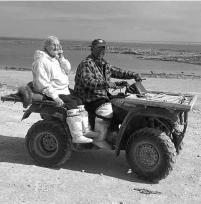
First Air, based in Iqaluit, provides jet service to more than a dozen locations throughout the northern archipelago (group of islands), as well as Ottawa, Montreal, and Nuuk, Greenland. Air Inuit flies from Cape Dorset and Sanikiluaq to points along the northwestern coast of Québec and to Montréal. NWT Air and Canadian North also provide air service.
11 HISTORY
Exploring the Arctic Islands
The first Inuit (the name given to Eskimos in Canada) are believed to have come from across the Bering Strait, which separates Asia and North America, on a land bridge about 5,000 years ago. They spread east along the Arctic coast and were the only people in the area for thousands of years. The Vikings of Europe sailed to the eastern Arctic islands about AD 1000, but they did not remain there and consequently had little impact on the region.
It was not until the 1570s that serious exploration of the northernmost part of North America began under the leadership of Englishman Martin Frobisher. In 1610, English explorer Henry Hudson—while looking for a passage to Asia—landed briefly on the western shore of the bay that now bears his name. Five years after Hudson's arrival, William Baffin and Robert Bylot mapped the Baffin coastal region in detail. Baffin Island, which is located south of Greenland, was virtually ignored during the following two centuries, as it was too cold and barren to be of interest to Europeans, but their discoveries opened the door for future exploration of northern Canada.
With the arrival of fur traders in the late 1700s and whalers in the 1800s, life in the region began to change substantially. The Europeans reshaped the North, bringing with them a new economy and a way of life much different than that of the Inuit. Communities grew around trading posts, mission schools, and Royal Canadian Mounted Police stations. In 1821, English explorer William Edward Parry spent two winters exploring and mapping the Igloolik area and helped establish friendly relations with the Inuit. In the mid-1840s, Sir John Franklin led several unsuccessful expeditions in search of the Northwest Passage (an ice-free sea route between the Atlantic and Pacific Oceans through the Arctic).
In 1870, as the whaling industry began to decline rapidly, the British government transferred control of what were then called the Northwest Territories to Canada. This included land that would one day become Nunavut. Ten years later, the British government added the scattered islands of the Arctic, which also became part of the Territories. The westernmost regions of Nunavut were the last to be explored by non-Inuit voyagers.
The High Cost of European Influence
During the 1920s and 1930s, missionaries—very eager to convert the Inuit to Christianity—began to establish the first residential schools. They took children as young as age 5 away from their families to live at these schools and immerse them in the Christian way of life. Many traditional beliefs and cultural practices of the Inuit people were lost as a result. The missionaries were also responsible for establishing some of the first hospitals in the territory.
By World War II (1939–45), mineral exploration (notably the development of nickel mines) and the military were also playing a role in northern Canadian development. The US Air Force constructed an airbase at Frobisher Bay (now Iqaluit) as part of a supply link to Europe, making it the commercial center for the Baffin region. In the 1950s, northern Canada was viewed as an important defensive area separating North America from what was then the Soviet Union.
Nunavut Land Claims
The issue of settling aboriginal land claims in the Northwest Territories took up much of the 1960s and 1970s. By 1976, the Inuit people had called for the creation of a separate territory, the Nunavut territory. Four years later, in 1980, the Northwest Territories Legislative Assembly voted in favor of dividing the territory to create Nunavut. Any such move would require federal approval, however, and negotiations for this continued for many years.
The Nunavut Land Claims Agreement of 1993 authorized the creation of the new territory of Nunavut, with the federal government splitting the Northwest Territories into two parts on 1 April 1999 (the eastern portion being the new territory). The agreement gave the Inuit rights to 355,842 square kilometers (137,355 square miles or 19% of Nunavut's total area), with mineral rights to 35,257 square kilometers (13,069 square miles). In addition, the federal government agreed to pay the Inuit C $1.148 billion between 1993 and 2007. The Inuit also received territorial hunting rights, a greater role in the management of land and the environment, and a share of government royalties from oil, gas, and minerals extracted from federal lands.
The Bathurst Mandate Pinasuaqtavut is a government plan outlining future goals for the territory. There are four main goals: healthy communities, simplicity and unity, self-reliance, and continuing learning. Premier Paul Okalik in 2004 was attempting to put those goals into action to improve the lives of Nunavut citizens.
12 PROVINCIAL GOVERNMENT
Nunavut is unique in North America as it has the first government to be administered primarily by Native people. As in the NWT and the Yukon, political power rests with elected representatives. Executive power is held by a 19-seat elected legislature. This assembly then appoints the premier for the territorial government.
Besides Iqaluit, the decentralized territorial government also has administrative offices in Rankin Inlet, Cambridge Bay, Cape Dorset, Arviat, Gjoa Haven, Kugluktuk, Pangnirtung, Baker Lake, and Pond Inlet.
13 POLITICAL PARTIES
The first election was held on 15 February 1999. Of Nunavut's 12,210 eligible voters, 88 percent participated in the province's first election. The second election was held on 16 February 2004 to elect 19 members of the Legislative Assembly. Nunavut operates on a consensus government system, with no political parties.
| Term | Premier |
| 1999– | Paul Okalik |
14 LOCAL GOVERNMENT
Nunavut is divided into three administrative regions: Qikiqtaluk, which includes Baffin Island and the northern archipelago (group of islands) and islands in Hudson Bay; Kivalliq, which covers southern Nunavut; and Kitik meot in the west.
15 JUDICIAL SYSTEM
The Canadian Constitution grants territorial and provincial jurisdiction over the administration of justice, and allows each territory and province to organize its own
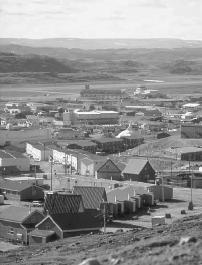
The territorial court system consists of the Nunavut Court of Justice. It is Canada's first and only single level court, which handles cases that otherwise would be tried in both territorial courts and territorial supreme courts.
In 2002, there were 2 homicides in Nunavut. That year, there were 7,094 violent crimes per 100,000 persons, and 6,105 property crimes per 100,000 persons.
16 MIGRATION
Nunavut has been occupied continuously for more than 4,000 years. Paleoeskimo people emigrated from what is now Alaska in small groups beginning 4,000 years ago to as recently as 700 years ago. Another wave of migration came 1,000 years ago when whale-hunting Neoeskimo people entered Nunavut.
In 2001, 27.8 percent of the 450 immigrants living in Nunavut had come from the United Kingdom, 12.2 percent from the United States, and 11.1 percent from Northern and Western European countries other than the United Kingdom. Many immigrants in recent years have come from the Philippines and Germany.
In 2001, 0.5 of the residents of Nunavut age 5 and older were living abroad. Some 8.1 percent were living elsewhere in the territory, while 10.8 percent were living in another province.
17 ECONOMY
The traditional subsistence activities of the Inuit—fishing, hunting, and trapping—have an impact on the territorial economy. Fur harvesting continues to be very important, supplementing the income of many Inuit families. Until the mid-1960s, some parts of Nunavut maintained a subsistence economy, surviving from hunting and fishing, exchanging furs for small items from trading posts.
Hunting seals for their fur was a major industry in Nunavut until the 1970s, when public sentiment and political lobbying caused the United States and several countries in Europe to ban imports of marine mammal products. As a result, joblessness increased and Nunavut's economy lost some C $2 million per year.
Inuit arts and crafts distribute a greater amount of income more widely than any other economic activity.
With the new territorial status of Nunavut, construction in the Iqaluit area is booming, with new commercial buildings, apartments, and the legislative building.
In 2002, Nunavut had a gross domestic product (GDP) of C $931 million.
18 INCOME
The average family income in Nunavut in 2000 was C $59,206 for a family of five.
19 INDUSTRY
Industry in Nunavut centers on fish and meat processing. The value of manufacturing shipments in 2002 was C $2.1 million.
20 LABOR
As of 1999, the labor force of Nunavut totaled 10,904. There were 8,646 people employed, leaving an unemployment rate of 20.7 percent. The leading employment sectors were government, 20 percent; education, 13 percent; and retail service, 12 percent. There are few salaried jobs available outside of the public sector.
21 AGRICULTURE
A brief but intense summer growing season (due to the midnight sun) limits local production of crops, of which seasonal berries and produce for home consumption are the most prominent. Nunavut had no farms as of 2001.
22 DOMESTICATED ANIMALS
For about 2,000 years, the Inuit have bred qimmiit (Eskimo huskies) as draft animals to carry packs and later to pull sleds. Before modern transportation was available, dog teams often served as the primary form of transportation during the winter months.
23 FISHING
Sport fishing is a popular activity and is a source of income from tourism. In 2000, there were 662 active resident anglers in Nunavut. Principal species sought in Nunavut include arctic char, arctic grayling, and lake trout.
24 FORESTRY
Except for small areas of the south and west, Nunavut lies entirely north of the tree line (the border area just warm enough for trees to grow). There is no forestry in Nunavut; firewood is in short supply.
25 MINING
In 2003, the total value of mineral production was C $29.9 million, with gold and silver accounting for virtually all of this amount.
Nunavut's Polaris lead-zinc mine on Little Cornwallis Island was the most northerly base-metal mine in the world. The Polaris mine shut down in 2002.
26 ENERGY AND POWER
Oil and gas exploration and development are important to the territory's economy, but the industry is open to wide fluctuations in world markets. It is estimated that about C $65 million was invested in Nunavut in 1999 by the mineral exploration industry. Nunavut has 23 percent of Canada's estimated natural gas reserves, worth more than C $1 trillion. It also possesses 10 percent of Canada's oil reserves, but petroleum exploration companies did not explore the territory in 2003 for a third year in a row. It is expensive to drill in Nunavut, and the land is not easily accessible. Nunavut has 614 million barrels of recoverable oil. It also has 12.4 trillion cubic feet (0.35 million cubic meters) of recoverable natural gas. The Sverdrup Basin, 800 kilometers (497.1 miles) north of Cambridge Bay, was the site of past petroleum production activity. The Drake Point natural gas discovery is among the largest in Canada, but there is no economical way to extract the gas.
27 COMMERCE
In 2002, total merchandise exports for the Nunavut, the NWT, and the Yukon
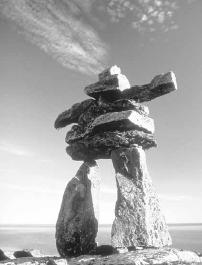
Inuit arts and crafts account for a great amount of retail income in Nunavut, spread out over a wide geographical area. Services related to tourism have become increasingly important sources of income.
28 PUBLIC FINANCE
As of 1 April 1999, Nunavut received a grant of about C $600 million per year for five years directly from the federal government. The grant was expected to account for 95 percent of the territory's public revenues, with income, sales, fuel, and property taxes accounting for the remainder. Territorial government revenues for the 2002/03 fiscal year were estimated at C $729 million, and expenditures at C $817 million.
29 TAXATION
There is no provincial sales tax. The tax on cigarettes is C $31.20 per carton. A gasoline tax of C $0.64 per liter is also levied.
The territorial income tax rates in 2003 ranged from 4 to 11.5 percent. The combined federal/territorial tax rate on ordinary income was 40.5 percent for the top marginal rate.
30 HEALTH
In 2001, there were 710 live births, a decrease of 2.3 percent from 2000. There were 12 deaths. Life expectancy for men in 2001 was 66.4 years, and 71 years for women. These rates were the lowest in Canada. Reported cases of selected diseases in 2002 for Nunavut included gonococcal infections, 78; chicken pox, 70; giardiasis, 12; and salmonellosis, 26. Between 2000 and 2003, 2 residents had become infected with HIV, the virus that causes AIDS.
Iqaluit has a well-equipped community hospital; smaller communities have community health centers (nursing stations). Air ambulance (Medevac) service is available and is coordinated by the local nursing stations.
31 HOUSING
Government housing programs stimulated the popularity of permanent housing so that by the mid-1960s, most Inuit no longer permanently lived in traditional camps.
In 2001, Nunavut had 7,175 households. The average household size was 3.7 persons, the highest number in Canada. Due to permafrost and a short construction season, the cost of building a house is more expensive in Nunavut than elsewhere in Canada. In 2001, 4,215 households lived in single-detached houses, 140 households lived in apartments in buildings with five or more stories, 5 households lived in mobile homes, and 2,810 households lived in other dwellings, including row houses and apartments in buildings with fewer than five stories.
For the 2001/02 fiscal year, the Government of Nunavut allocated about C $54 million to the Nunavut Housing Corporation to assist with housing shortages. In 2001, C $57.3 million was invested in residential construction in Nunavut.
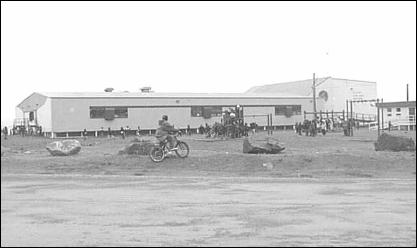
32 EDUCATION
Federal schools were built in most Baffin communities in the 1950s and 1960s. All elementary and secondary schools in Nunavut are public. The Arctic College (with centers in Rankin Inlet, Cambridge Bay, Iqaluit, and Igloolik) offers community college courses.
33 ARTS
Many communities in Nunavut have artisans who produce clothing, accessories, tools, weavings, beadwork, carvings, or prints. Studios are often found in the more populous areas of Pangnirtung, Iqaluit, Cape Dorset, Baker Lake, and Rankin Inlet.
34 LIBRARIES AND MUSEUMS
Central headquarters of the Nunavut Public Library Service were located in Iqaluit, where the Iqaluit Centennial Library collection is maintained. The Headquarters Centre of the NPLS was scheduled to open in the summer of 2004 in the Kivalliq community of Baker Lake. Member libraries are located in Arviat, Cambridge Bay, Clyde River, Kugluktuk (Coppermine), Iqaluit, Nanisivik, Pangnirtung, Pond Inlet, and Rankin Inlet. The Nunatta Sunaqutangit Museum is in Iqaluit.
35 COMMUNICATIONS
Nunavut has an AM radio station in Iqaluit and 3 FM stations (Rankin Inlet, Baker Lake, and Alert). There are no television stations in Nunavut, but the Canadian Broadcasting Corporation (CBC) North transmits to Iqaluit and other communities. The Inuit Broadcasting Corporation (IBC) develops programming in Inuktitut. Iqaluit is Canada's northern-most community with cellular telephone service.
36 PRESS
Weekly newspapers available in Nunavut include Nunatsiaq News , News/North , and Kivalliq News .
37 TOURISM, TRAVEL, AND RECREATION
Tourism is increasingly important. Nunavut offers a variety of landscapes of great natural beauty, which are well-suited to fishing, hunting, wildlife observation and photography, and other outdoor activities. Tourism in Nunavut annually contributes some C $30 million to the economy. Nunavut has three national parks: Auyuittuq National Park, on Baffin Island north of Pangnirtung; Ellesmere National Park, on northern Ellesmere Island; and Sirmilik National Park, on northern Baffin Island. In addition, there are several territorial and historic parks and 20 bird and game sanctuaries.
38 SPORTS
Local sporting organizations (for such sports as badminton, basketball, track and field, and volleyball) are popular in the territory, as are canoeing and kayaking. The Nunavut 200 is an annual dog sled race from Arviat to Rankin Inlet. The Midnight Sun Marathon is an internationally known annual race from Arctic Bay to Nanisivik.
39 FAMOUS NUNAVUMMIUT
Qillaq (Qitdlarssuaq) led one of the last Inuit migrations from Baffin Island to northwest Greenland in the 1850s and 1860s. John Amagoalik was instrumental in the design of the new territory's government. Paul Okalik (b.1964) became the first premier in 1999; he was re-elected in 2004.
40 BIBLIOGRAPHY
Daitch, Richard W. Northwest Territories . Minneapolis: Lerner Publications, 1996.
Hancock, Lyn. Nunavut . Minneapolis: Lerner Publications, 1995.
Lutz, Norma Jean. Nunavut. Philadelphia: Chelsea House, 2001.
McGhee, R. Ancient People of the Arctic . Vancouver: University of British Columbia Press, 1996.
Mowat, Farley. Walking on the Land. S outh Royalton, VT: Steerforth Press, 2001.
Roy, Geoffrey. North Canada: Yukon, Northwest Territories, Nunavut: The Bradt Travel Guide. Guilford, CT: Globe Pequot, 2000.
Soublière, Marion, ed. The Nunavut Handbook . Iqaluit, Nunavut: Nortext Multimedia Inc., 1998.
Weihs, Jean. Facts about Canada, Its Provinces and Territories . New York: H. W. Wilson, 1995.
Web sites
Government of Nunavut. http://www.gov.nu.ca (accessed on March 22, 2004).
Statistics Canada. http://www.statcan.ca/start.html (accessed on March 22, 2004).
Travel Canada: Nunavut. http://www.travelcanada.ca/tc_redesign/app/en/ca/destinations.do?provinceId=9 (accessed on March 22, 2004).
THANK YOU
Hello, good evening from Talence in France,
We are students from CM2 (grade
5/6- 10 to 11 years) in Saint-Exupery
primary school in Talence (southern
suburb of Bordeaux). Bordeaux is a cityharbour
in southwestern France. The landscape of our region is formed by
limestone plateau with caves often occuped since praehistory, river valleys
that have the greatest vineyards of France and the sandy plains of the
Landes forest. The Atlantic Ocean is 50 km further west, a paradise for
surfing. Landes forest is the biggest in western europe.
Our school project focuses on Living Together, the
mastery of written and spoken language. The discovery of
our culture and those of others, especially those of the
First Peoples of the various continents, is one of the
supports. We would correspond either individually or
collectively from class to class, exchanging letters, texts,
drawings, records, games, songs, newspapers ... The number
of students is not a problem. We would like discover your
country, your culture and your current life and traditional,
your music, your language (translated in English please), your school ...
We hope our idea will interest you and we await your
response and we thank you in advance.
We are hopeful earing you soon,
The Cm2 class from Saint-Exupery
Elementary School of Talence (France).
Very enjoyed~~ Kenzieee
I would like to know more on houses - rent rates and grocery prices in present 2011.
Thank you.
Kamlesh
websites weren't very helpful with the information that I needed for the project. I'm so glad there is at least one website that doesn't just tell you that there's stuff about Nunavut and then turn out to be some phony website that just wants to send a virus to your computer. Thank you for the information!
Beast
I am considering a job offer in Nunavut, it is in the HR field. Can someone tell me the salary range for this type of position and the average cost of a 2-3 bedroom home.
Thank you
Thank you this site was very helpful!